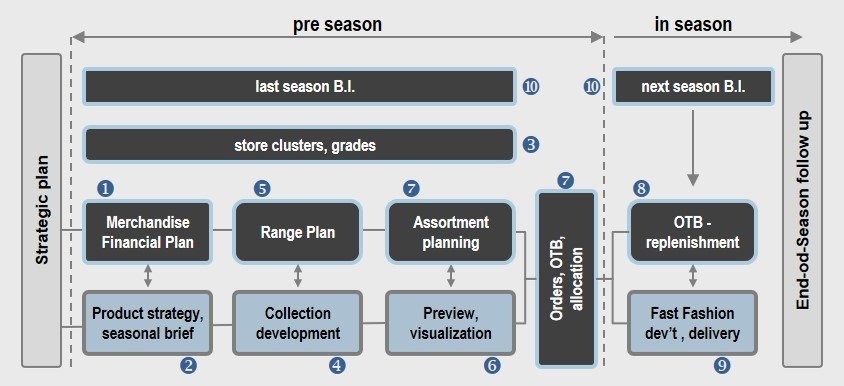Ispira supports the evolution of all stages of Merchandise Planning process.
Our projects have delivered solid financial results as:
. increased percentage of full price sales
. increased realised gross margin
. increased full price and end-of-season percentage sell through
The most common areas of involvement are:
. Merchandise Financial Plan: align and reconcile plan by Country Channel and Product Plan; derive strategic seasonal KPIs; plan like for like and non-like for like targets
. Product strategy, seasonal brief: define customer personas, market position, range extension, key collection capsules, projects, assortment segmentation principles
. Store clusters and grades: define analytical model to segment store network through qualitative drivers (clusters), space and sales (grades)
. Collection development: define product flows, detailed qualitative segmentation, identify product grouping principles, segment collection by lifestyle and sourcing areas; plan and control all qualitative assortment attributes as color, rate of sale, lifecycle, fabric, style, end use
. Range Plan: generate detailed planning tree including all relevant dimension; define assortment structure by delivery, cluster, grade; manage unit depth, number of options
. Preview, visualization: define key essential items, seasonal trends, basic, test products; validate product display and communication requirements
. Assortment planning: match range plan with real options by function, grade, delivery; manage progress and gaps to keep consistency with merchandise plan; product quantification
. Orders, OTB, Allocation: confirm product, manage Open to Buy progress for subsequent order releases; define product first allocation to stores
. OTB - Replenishment: review seasonal sales and markdown, reforecast end-of season metrics, update and release in-season OTB; manage in-season sales maximization actions; manage price and discount strategy
. Fast Fashion development , delivery: Fast Fashion collection development, assortment planning, product grouping, product role, product visualization
. Last season, Next season B.I.: ongoing specific product performance analysis, review of qualitative attributes, analysis of customer feedback, constant feeds into merchandise planning
An advanced assortment planning process is key to profitable retailing, as it provides the framework for converting strategic and financial objectives into detailed, customer-focused range plan
It's the quantitative support for collection development, segmentation, product lifecycle. It also represents the basis for performance monitoring and sales maximization actions during the season.
We apply a 10 step Best Practice process using our proprietary planning system (see our systems section for more detail), to ensure that top-down and bottom-up planning is conducted in a straightforward and systematic manner
Key input for Retail Planning is Store Grading model which needs to take into account qualitative aspects of distribution networks, store size and sales value to drive product mix, number of options and unit depth
Our Retail Assortment Planning methodology links your strategy to seasonal budgeting and tailored assortment structures, and ensures planned Best Sellers are identified and quantified accordingly for each store, store grade, and region.
For e-commerce, assortment planning follows more complex rules. Digital channels offer the opportunity to build multiple paths to purchase. The same option can be reached following new arrivals, functional, emotional, seasonal, convenience paths. Customers can create bespoke journey according to their profile.
Critical KPIs emerge for best practice range planning: duplicated vs non duplicated options, number of duplications per option, number of paths per option.
Omnichannel Range Planning – designing the retail experience
Our colleague Agnieszka Adamkiewicz is expert in developing best retail planning methodology and in supporting the client's team through the validation and implementation process.
Range and Assortment Planning are now available as Outsourced Service
Ispira's areas of delivery:
> review and plan sales, margins and stock
> review and plan range structure and product mix
> review and plan the price architecture and flow of goods
> establish product roles and sales potential to allocate the correct unit depth
> develop plans by store cluster and store grade
> use of our planning application to support range planning
> develop bespoke algorithms to execute innovative planning process


